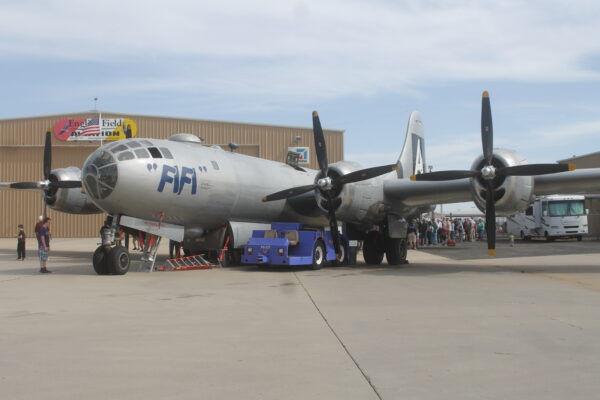

B-29 bomber airplane, “FIFI”, stopped at the Texas Air and Space Museum in Amarillo and offered tours and rides.
The year is 1941; Pearl Harbor has just been attacked, war bonds are being sold and young men across America are putting their draft cards to use. World War II will take its toll across the world for four more years with an estimated 48.2 million deaths in total, according to the War Chronicle website.
Flash forward to 1945; World War II is coming to a close and Japan has surrendered after the destruction of two major cities, Hiroshima and Nagasaki. The bombs, nicknamed “Little Boy” and “Fat Man,” were dropped from two different B-29 bomber planes named the “Enola Gay” and the “Bockscar.”
The Texas Air and Space Museum in Amarillo hosted a similar plane at the beginning of the month, a B-29 Superfortress. Her name is “FIFI,” and she stands at 29 feet, 7 inches tall, exactly 99 feet in length and has a wingspan of 141 feet, 3 inches. She visited Amarillo as part of a seven-week Commemorative Air Force tour.
According to Boeing’s website, of about 4,000 B-29s assembled, “FIFI” remains as the only airworthy aircraft, at least so far.
“‘FIFI’ is the only restored B-29,” museum employee Bud Cochran said. “Another is currently being restored in Wichita, Kansas.” Its name is “Doc,” and it is expected to be finished by the end of 2015.
While many would say the Superfortress was impressive, it wasn’t free of its issues.
“It was designed for a high altitude of above 30,000 feet. It went into service dropping iron bombs, but it developed that the accuracy was bad,” B-29 crew member Jim Bowerman said.
Bowerman said the attack altitudes were lowered to between 10,000 and 15,000 feet, which improved the accuracy substantially, but casualties also increased now that enemy planes could get to them easier because of their lowered location.
“The B-29 was designed for the European theater,” crew member Col. Burney Baskett said. “They thought that Britain was going to fall, so the specifications were for a bomber that could reach Germany and back. Britain didn’t fall and they didn’t need the range, so they shipped her to the Pacific theater.”
The term “theater” in warfare means the “area of air, land and water that is, or may become directly involved in war,” according to the Military Factory website. Even though the B-29 is most known for dropping the atomic bombs, it did have other uses.
“In the latter part of the war, this type of airplane used incendiary bombs,” Bowerman said. “The reason was because Japanese cities were primarily wood and paper, so it created huge damage.”
Unlike the Enola Gay and Bockscar, “FIFI” never was in combat.
“She was put into service on July 31st, 1945, but didn’t fly in a bomb run,” Cochran said. “It has been all over on tours, though.”
The 70-year-old plane has traversed the world and will continue to be a symbol of the sacrifices of the men and women who gave their lives during World War II and throughout history.

Leave a Reply